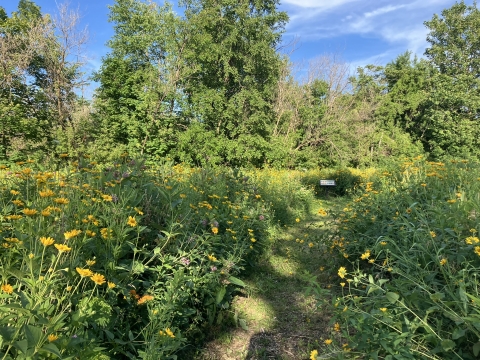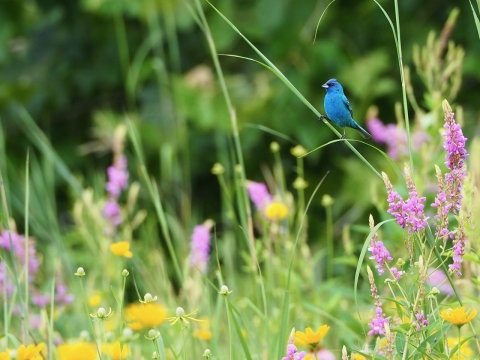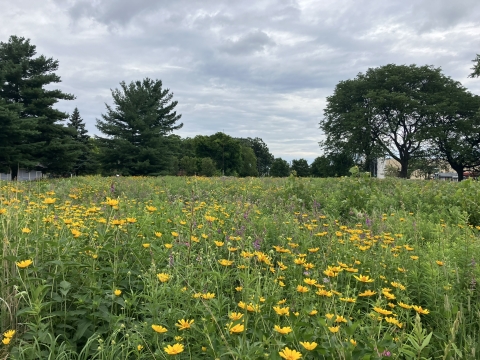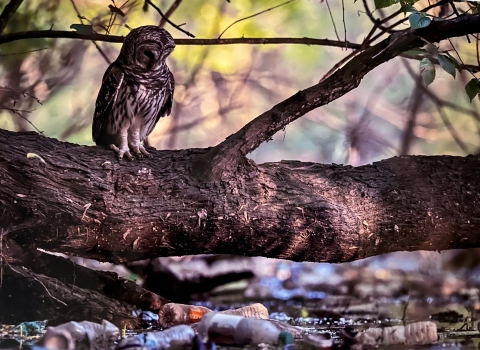Since 2017, Detroit Bird Alliance, the City of Detroit, U.S. Fish and Wildlife Service, Detroit Zoological Society, Urban Neighborhood Initiatives, and many other community organizations, have been undertaking the Detroit Bird City project supported by the Urban Bird Treaty program and the National Fish and Wildlife Foundation’s 5 Star and Urban Waters Restoration Grant program. Together Detroit partners—in collaboration with the community—are transforming underutilized parks into beautiful community greenspaces with meadow habitat, providing a haven for birds, insect pollinators, and visitors alike.
By 2024, partners created about 20 acres of meadow, and another 25 are in the process of being planted by the end of 2024, bringing the total meadow acreage to over 45 acres. At each park, partners have planted native species based on cooperative planning and habitat design with community members that has resulted in signage, seating, and paths, as well as educational programs and conservation events, exemplifying the Service’s Standards of Excellence for community engagement. The meadows provide critical ecological services such as pollination, stormwater capture, carbon sequestration, and air and water pollution mitigation. The signage, seating, and paths ensure that the parks are purposeful, safe, and welcoming to people.
At Callahan Park—the first Detroit Bird City park planted in 2019—partners worked with volunteers to pick up trash, clear pavement, and till the area to remove turf grass and invasive species invasive species
An invasive species is any plant or animal that has spread or been introduced into a new area where they are, or could, cause harm to the environment, economy, or human, animal, or plant health. Their unwelcome presence can destroy ecosystems and cost millions of dollars.
Learn more about invasive species . Then they planted seeds for various native flowers and grasses donated by the U.S. Fish and Wildlife Service, including milkweeds, asters, goldenrods, sunflowers and many others. These plants have attracted honeybees, bumble bees, carpenter bees, leafcutter bees, swallowtails and monarch butterflies. Pollinating insects require both host and nectar plants provided by the native flower meadows.
Birds facing the greatest declines include migratory and grassland species that benefit from meadow habitats restored with native plants. Although the habitat will take time to reach its full wildlife potential, volunteers have recorded over 100 species of birds during their monitoring visits at Callahan Park. Community members are thoroughly enjoying seeing indigo buntings, scarlet tanagers, gray catbirds, chipping sparrows, and American goldfinches. Detroit is a migration hotspot, particularly in the fall when birds funnel through the Detroit River corridor during migration. By turning unused land commonly filled with trash and invasive species into meadow habitats, these areas can support struggling birds during their migratory journeys – considered the most hazardous life phase for these species.
The parks also benefit the City of Detroit and Detroiters! Traditional parks and lawns are typically mowed regularly, but the native meadows, once established, only require mowing once a year. By embracing natural native landscapes, the city saves significant time and resources while providing an important resource for residents and wildlife. These meadows also help the city with stormwater and drainage issues. Native plants have much larger, complex root systems that allow them to soak up rainwater and store it instead of letting the water overflow the Detroit sewer system. The city cites Callahan Park in a draft strategic plan as an example of how to convert underused parks into natural areas. Partners plan to expand to other city properties, helping the parks department achieve its vision for 1,500 acres of wildlife habitat across Detroit!
The native meadows will provide much-needed accessible and inviting greenspace to local underserved and marginalized communities that do not have adequate access to the mental and physical benefits of nature. Studies show that spending time in nature and birdwatching can lower stress, improve sleep, increase focus, improve immune function, and lower blood pressure. Natural habitat areas also offer opportunities for exploration and experience-based learning, especially for children.
Detroit Bird City is contributing to a growing body of research on how natural areas can improve people’s well-being. In a National Cancer Institute–supported study, Michigan State University health geographer Amber Pearson is tracking how Detroit neighbors’ physical and mental wellness responds to the vibrant plant life and soothing birdsong. Detroit is still recovering from decades of disinvestment in its parks. Detroit partners are prioritizing habitat improvements in neighborhoods the city's park renaissance hasn’t reached, thus helping improve the health and well-being of underserved communities, while providing important habitat for migratory birds, pollinators, and other declining wildlife populations.







